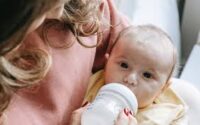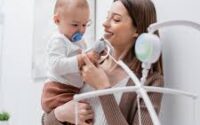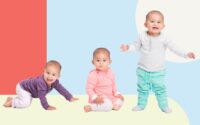Tips for Creating a Safe Sleep Environment for Your Baby
Creating a safe sleep environment for your baby is essential for promoting healthy sleep and reducing the risk of Sudden Infant Death Syndrome (SIDS). This guide covers practical tips on crib safety, safe sleep positioning, swaddling, and room temperature to give parents peace of mind at bedtime.
1. Crib Safety: Setting Up a Secure Sleep Space
A safe crib setup is key to ensuring your baby’s safety while sleeping. Here are essential crib safety tips:
- Choose a Firm, Flat Mattress: A firm mattress with a fitted sheet helps reduce suffocation risks. Avoid soft mattresses or memory foam, which can pose a hazard.
- Check Crib Standards: Use a crib that meets the latest safety standards. Avoid older cribs with drop sides or gaps larger than two fingers between the mattress and crib walls.
- Avoid Loose Bedding: Keep the crib bare of blankets, pillows, stuffed animals, and bumper pads, as these can increase the risk of suffocation.
Tip: Always place the crib away from windows, blinds, or cords to prevent accidental entanglement.
2. Always Place Your Baby on Their Back to Sleep
One of the most important safe sleep practices is to place your baby on their back every time they sleep, both at night and during naps.
- Back Sleeping Reduces SIDS Risk: Studies show that placing babies on their backs significantly reduces the risk of SIDS. Side and stomach sleeping can increase the risk of airway obstruction.
- Use a Firm Sleep Surface: Whether in a crib, bassinet, or play yard, place your baby on a firm sleep surface without any padding.
Tip: Once your baby can roll over on their own, it’s okay to let them find their own sleep position, but always start them on their back.
3. Swaddling Safely: Providing Comfort Without Risk
Swaddling can help babies sleep more soundly, but it’s essential to do it correctly to ensure safety.
- Use a Proper Swaddling Technique: Keep the swaddle snug around the baby’s chest but loose around the hips to allow for natural movement. Overly tight swaddling can restrict breathing or hip movement.
- Stop Swaddling at Rolling Stage: Once your baby shows signs of rolling over (usually around 2-4 months), it’s time to transition out of swaddling to avoid the risk of suffocation.
- Consider Sleep Sacks: Sleep sacks are wearable blankets that keep your baby warm without the risks associated with traditional blankets.
Tip: Use lightweight, breathable materials for swaddling to avoid overheating.
4. Control Room Temperature to Prevent Overheating
Maintaining a comfortable room temperature is important, as overheating is a known risk factor for SIDS.
- Aim for 68-72°F (20-22°C): This temperature range is ideal for keeping babies comfortable and safe while they sleep.
- Dress Baby Appropriately: Dress your baby in light layers based on the room temperature, avoiding excessive blankets or heavy clothing.
- Use a Fan for Air Circulation: Studies have shown that using a fan to circulate air can reduce the risk of SIDS by keeping the air fresh and preventing overheating.
Tip: If you’re unsure, check your baby’s temperature by feeling their neck or back. It should be warm, not sweaty.
5. Room-Sharing vs. Bed-Sharing: The Safer Choice
The American Academy of Pediatrics recommends room-sharing without bed-sharing for the first six months to a year.
- Room-Share with a Separate Sleep Surface: Keeping your baby in your room but in a separate crib or bassinet can reduce the risk of SIDS by up to 50%.
- Avoid Bed-Sharing: Bed-sharing increases the risk of suffocation and entrapment, especially if parents are very tired or under the influence of medications or alcohol.
Tip: A bedside bassinet can offer a convenient way to keep your baby close without the risks of bed-sharing.
6. Use Pacifiers for Sleep (If Baby Accepts It)
Offering a pacifier at nap time and bedtime may reduce the risk of SIDS.
- Introduce After Breastfeeding Is Established: If breastfeeding, wait until about 3-4 weeks to introduce a pacifier to prevent nipple confusion.
- Don’t Reinsert Once Baby Falls Asleep: If the pacifier falls out after your baby is asleep, there’s no need to put it back in.
- Choose a Safe Pacifier Style: Avoid pacifiers with cords or clips, as these can pose a strangulation risk.
Tip: If your baby rejects the pacifier, don’t force it. Not all babies like them, and they’re just one option among many for safe sleep.
7. Avoid Smoking Around Baby to Improve Sleep Safety
Smoke exposure is a major risk factor for SIDS and other respiratory issues in infants.
- Avoid Smoking Indoors or Near Baby: Keep a smoke-free environment around your baby, as even secondhand smoke increases risks.
- Don’t Let Others Smoke Around Baby: Avoid having visitors who smoke around your baby, and keep their sleeping area free of any smoke residue.
Tip: Wash your hands and change clothes if you’ve been around smoke before handling your baby.
Final Thoughts: Creating a Safe Sleep Environment for Your Baby
By following these safe sleep practices, you can create a secure and comfortable sleep environment for your baby, reducing the risk of SIDS and other sleep-related hazards. Remember, a safe crib, a consistent sleep routine, and thoughtful temperature control can go a long way in ensuring your baby sleeps safely. Each safe sleep decision supports their health, giving you more peace of mind as they rest.


